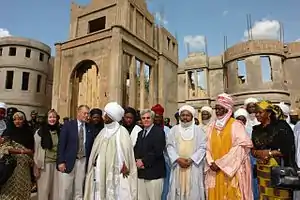Gombe Emirate
The Gombe Emirate is a traditional state in Nigeria that roughly corresponds in area to the modern Gombe State.[1] Gombe state also contains the emirates of Dukku, Deba, Akko, Yamaltu, Pindiga, Nafada and Funakaye.[2] The current Emir of Gombe is Alhaji Abubakar Shehu Abubakar III, who acceded on 6 June 2014. The late Emir of Gombe, Alhaji Shehu Usman Abubakar, had been Emir since August 1984.[3]

Early history
The Gombe emirate was founded in 1804 during the Fulani jihad by Buba Yero, a follower of Usman dan Fodio.[4] Buba Yero made Gombe Aba his headquarters for a campaign against the Jukun settlements of Pindiga and Kalam, followed by extensive raids in which he went as far as Adamawa on the other side of the Benue River. Further lands were subdued by his son, Muhammadu Kwairanga, Emir of Gombe from 1844 to 1882.[5] The Gombe emirate at one time extended from Gombe Aba to Jalingo, but in 1833 the Muri Emirate was created from part of its territory to form a state for the Emir's brother.[6]
During the reign of Emir Zailani (1882–1888) a religious zealot, Mallam Jibril Gaini, established himself at Burmi on the border between Gombe and Fika. Gaini managed to hold out for years against the combined forces of Gombe and neighboring emirates, and was finally defeated and exiled by the British Royal Niger Company in 1902.[5] The British conquered Gombe at the battle of Tongo in 1902. They moved the capital of Gombe to Nafada in 1913, and moved the capital again in 1919 to the present Gombe town. Waja was separated from Gombe in 1930 to become an independent District.[6] However, the Waja headmen chose Sarkin Yaki of Gombe, brother of the former Emir Umaru dan Muhammadu, as their chief.[7]
Post-colonial era
The British had set up the Gombe Native Authority system, which continued to function after independence in 1960. In 1976, the military regime of Olusegun Obasanjo broke up the Native Authority into the Gombe, Akko and Dukku Local Government Areas. In 2002, Gombe State Governor Abubakar Habu Hashidu broke up Gombe Emirate into parts, ruled by 2nd Class Emirs and two Senior District Heads. The following year Governor Mohammed Danjuma Goje created two additional Senior District Heads. This has reduced the authority of the Emir at a time of increasing conflict between farmers and nomadic Udawa herders, compounded by violence from extremist religious groups.[6]
Rulers
Rulers of Gombe Emirate:[8]
| Start | End | Ruler |
|---|---|---|
| 1804 | 1841 | Abubakar "Buba Yero" dan Usman Subande (b. c.1762 – d. 1841) |
| 1841 | 1844 | Sulaymanu dan Abubakar (d. 1844) |
| 1844 | 1882 | Muhammadu Kwairanga dan Abi Bakar (d. 1882) |
| 1882 | 1888 | Abd al-Qadiri Zaylani dan Muhammadu (d. 1888) |
| 1888 | 1895 | Hasan dan Muhammadu (d. 1895) |
| 1895 | 1898 | Tukur dan Muhammadu (d. 1898) |
| 1898 | 1898 | Jalo dan Muhammadu |
| 1898 | 1922 | Umaru dan Muhammadu (d. 1922) |
| 1922 | 1935 | Haruna dan Umaru (d. 1935) |
| January 1936 | January 1984 | Abu Bakar dan Umaru (b. 1902) |
| January 1984 | 27 May 2014 | Shehu Usman Abubakar |
| June 2014 | Present | Abubakar Shehu Abubakar III (b. 1977) |
References
- "Gombe State". Online Nigeria Daily News. Retrieved 21 September 2010.
- "About Gombe>Emirates/Traditional Councils". Gombe State. Archived from the original on 27 July 2013. Retrieved 27 May 2012.
- Julius Toba (23 January 2009). "Pomp, as Gombe monarch marks anniversary". Nigerian Compass. Retrieved 21 September 2010.
- "Gombe". Encyclopædia Britannica. Retrieved 21 September 2010.
- Jörg Adelberger. "Maxims and Mountaineers – The colonial subjugation of the peoples of the Muri Mountains and the adjacent regions in Northern Nigeria [1]". Afrikanistik online. Retrieved 21 September 2010.
- Roger Blench; Selbut Longtau; Umar Hassan; Martin Walsh (9 November 2006). "The Role of Traditional Rulers in Conflict Prevention and Mediation in Nigeria" (PDF). DFID, Nigeria. Retrieved 21 September 2010.
- C. A. Woodhouse (January 1924). "Some Account of the Inhabitants of the Waja District of Bauchi Province, Nigeria. Part I". Journal of the Royal African Society. Oxford University Press. 23: 110–121. JSTOR 715387.
- "Traditional States of Nigeria". World Statesmen. Retrieved 15 September 2010.